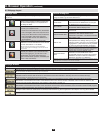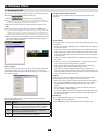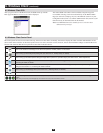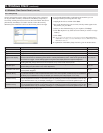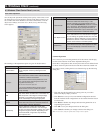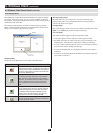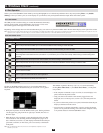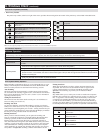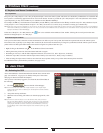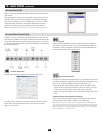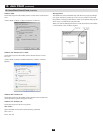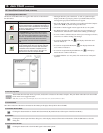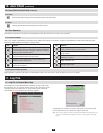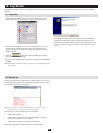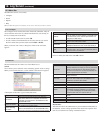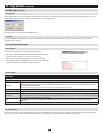
31
9.5 Keyboard and Mouse Considerations
9.5.1 Keystrokes
9.5.2 Mouse Synchronization
9. Windows Client
(
continued
)
Exceptfor[Alt+Tab]and[Ctrl+Alt+Del],allkeyboardinputissenttotheremotesystem.Theabovetwochordedkeycombinationsareretainedonthe
localsystemtoswitchamongapplicationsandtorecoverfromdisaster.Inordertoprovidethe[Alt+Tab]and[Ctrl+Alt+Del]functionsontheremote
system keyboard, you may select another key as a substitute for the Alt and/or Ctrl keys.
For example, the F11 key could substitute for the Ctrl key and the F12 key could substitute for the Alt key,inwhichcase[F12+Tab]substitutesfor[Alt
+Tab];and[F11+F12+Del]substitutesfor[Ctrl+Alt+Del].Seesection9.3.1,Hotkey Setup, for details on setting up a substitute key.
Note: While any key may be used as a Substitute key, you must not use one that is being used as the first position Hotkey for another action. Also, when the KVM switch is being accessed with Win 98
under Full Screen Mode, if you mistakenly press Ctrl + Alt + Del, you will have to exit the Windows Client (by clicking the arrow on the Windows Client control panel), and restart the Windows
Client from the Remote Control Main Webpage.
Inthecaseofthe[Ctrl+Alt+Del]function,the icon is also available on the Windows Client Toolbar. Clicking this icon will perform the same
functionashittingthe[Ctrl+Alt+Del]keys.
Until you close the remote connection, mouse movements have no effect on your local system, but instead are captured and sent to the remote system.
From time to time, especially if you change video resolution, the local mouse movement may no longer be synchronized with the remote system’s mouse
pointer. There are three quick methods that can be used to bring the two pointers back into sync:
Right-clickingonthehammericon• in the Windows Client Control Panel.
MovingthemousepointerintotheControlPanelandbackoutagain.•
Performing an • Auto SyncwiththeVideoAdjustmentfunction(seesection9.3.2,Video Adjustment, for details).
Invoke the • Adjust Mouse function with the Adjust Mousehotkeys(seesection9.3.1,Hotkey Setup, for details).
After activating the • Adjust Mouse function, move the local mouse pointer exactly on top of the remote mouse pointer and click.
Foradditionalmousesynchronizationprocedures,seepages32-33.
10.1 Activating the OSD
10. Java Client
AccesstheNetDirectorConsoleKVMSwitchwithIPAccessremotemain
page. (see section 8.1, Logging In, for details) The layout of the remote
main page is discussed in detail in Chapter 8.
Afteryouhavesuccessfullyloggedin,toactivatetheJavaClientOSD,do
the following:
Click the 1. button at the left of the Webpage.
Note: You must have Sun’s Java 2 JRE 1.4.2 or higher installed on your computer before
running the Java Client. Java is available for free download from the Sun Java Website:
http://java.sun.com.
Accept the security certificates.2.
When the browser dialog asks what to do with the program file, click 3.
Open.
Note: If the browser cannot run the file, save it to the hard drive. Then, with your browser
still open to the Remote Webpage, run the file from your disk. If you use the save to disk
method, for security purposes, you cannot simply run a previously downloaded version
of the program. Each time you want to remotely access the KVM switch, you must log
in to the Webpage with a valid username and password to download a fresh copy of the
program.



